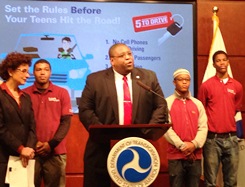 The U.S. Department of Transportation’s National Highway Traffic Safety Administration (NHTSA) today unveiled a new campaign that challenges parents to discuss five critical driving practices with their teenage drivers that can have the greatest beneficial impacts in the event of a crash. The new “5 to Drive” campaign is being launched to coincide with National Teen Driver Safety Week, October 20-26, 2013.
The U.S. Department of Transportation’s National Highway Traffic Safety Administration (NHTSA) today unveiled a new campaign that challenges parents to discuss five critical driving practices with their teenage drivers that can have the greatest beneficial impacts in the event of a crash. The new “5 to Drive” campaign is being launched to coincide with National Teen Driver Safety Week, October 20-26, 2013.
“Safety is our highest priority, especially when it comes to teens, who are often our least experienced drivers,” said U.S. Transportation Secretary Anthony Foxx. “The ‘5 to Drive’ campaign gives parents and teens a simple, straightforward checklist that can help them talk about good driving skills and most importantly, prevent a tragedy before it happens.”
NHTSA data show motor vehicle crashes are the leading cause of death for teenagers 14-18 years-old in the United States. In 2011, 2,105 teen drivers were involved in fatal crashes. Of those teens involved in fatal crashes, 1,163 (55 percent) survived, and 942 (45 percent) died in the crash.
The “5 to Drive” campaign encourages parents to visit www.safercar.gov/parents/teendriving and discuss with their teens one safety topic each day during national teen driver safety week. The “5 to Drive” campaign topics are:
- No cell phone use or texting while driving,
- No extra passengers,
- No speeding,
- No alcohol, and
- No driving or riding without a seat belt.
The list is designed to counteract poor driving decisions that have contributed heavily to the high death rate among teen drivers, as evidenced by:
- In 2011, over half of the teen occupants of passenger vehicles who died in crashes were unrestrained;
- Speeding was a factor in 35 percent of fatal crashes involving a teen driver;
- Twelve percent of teen drivers involved in fatal crashes were distracted at the time; and
- n 2011, 505 people nationwide died in crashes in which drivers between 14 and 18 years old had alcohol in their systems, despite the fact that all states have Zero Tolerance Laws for drinking and driving under age 21.
Peer pressure is also a contributing factor in teen crash deaths. When the teen driver in a fatal crash was unrestrained, almost four-fifths of that driver’s teen passengers were unrestrained as well. Moreover, one NHTSA study found that a teenage driver was 2.5 times more likely to engage in risky behaviors when driving with one teenage passenger and three times more likely with multiple teenager passengers.
“Inexperience and immaturity, combined with speed, drinking and driving, not wearing seat belts, distracted driving, and other teen passengers contribute to the high fatality rate of teens involved in fatal crashes,” said NHTSA Administrator David Strickland. “I encourage all parents of teenagers to have an open discussion with their teen about the dangers common among young drivers and to make sure they use our ‘5 To Drive’ program to develop the necessary skills to drive safely every trip, every time.”
Poor decisions among teen drivers can lead to crashes and fatalities at any time of the day, but fatal teen driver crashes are most frequent between 3 and 8 p.m., and remain high until midnight.
Read about Teen Driver Safety in NHTSA’s October issue of Safety in Numbers, a new online monthly newsletter on hot topics in auto safety – including problem identification, people at risk, and recommended practices and solutions to mitigate injury and death on our nation’s roadways.
For interesting quotes from teens themselves about risky driving behaviors, click here.
For more information on the “5 to Drive” campaign, visit www.safercar.gov/parents/fivetodrive.htm and join the conversation on Facebook and Twitter.
Search TeenAuto
Socialize with Us
Like us on FacebookFollow us on TwitterWatch our Channel